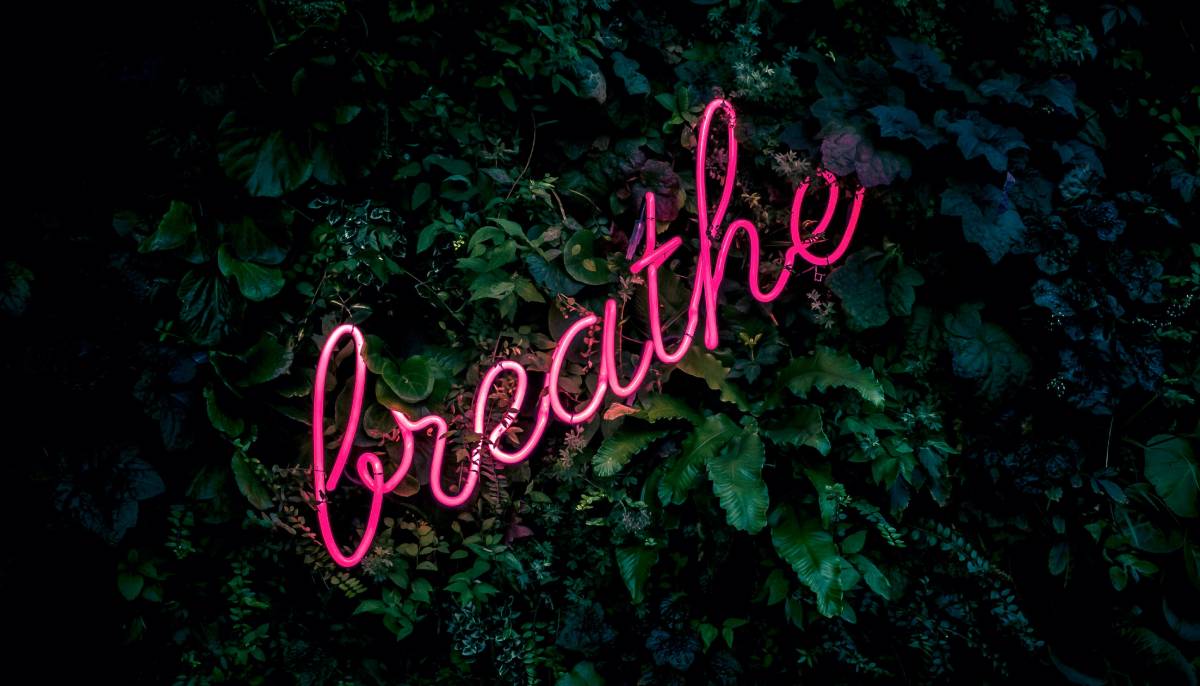Connect with your Breath
The breath is a powerful reminder of your anxiety-reducing connection with others, says Kamilah Majied.
Though we tremble before uncertain futures / may we meet illness, death and adversity with strength / may we dance in the face of our fears.
—Gloria E. Anzaldúa, in this bridge we call home
The second anniversary of the pandemic is a good time to reflect on the wisdom gleaned from this challenging experience. Notice the insights you’ve gained about how to be with yourself when you can’t be with others. We have been learning how to manage the anxious loneliness that often occurs and accrues as we limit our physical contact with people.
We often associate loneliness with sadness, but loneliness also has an anxious quality. The yearning to be social, to see smiles, hold hands, and hug one another can grip us in a field of angst. A breath practice can help us hold, release, and transform that anxiety.
As we grieve our deceased loved ones, our separations from living beloveds, and the absence of festivities that celebrate our connections, we may also experience anticipatory grief. We might worry about ourselves and loved ones getting sick in the future. We may worry that this pandemic will never end and find ourselves premourning future Covid-related losses. Grief and anticipatory grief can generate as much anxiety as they do sorrow. We can use the breath to release and learn from all aspects of grief.
The wonder of breathing is even more clear to us now. The threat and possibility of this, our shared air, reveals the threat and possibility of interdependence itself. Our exhalation is someone’s inhalation, and someone’s out-breath is our in-breath. Our breath is a reminder that we are connected no matter how lonely we feel.
May this breath practice help you transmute the anxiety of separation and loss. Repeat these words as you focus on your breath.
Breathing in, I notice that I miss you.
Breathing out, I embrace you with an intention for all beings to be well.
Breathing in, I notice worry that I will not endure.
Breathing out, I notice that I am enduring.
Breathing in, I grieve for my losses.
Breathing out, I thank impermanence for connecting me to all of life.
Conquer Anxiety with Kindness
Sylvia Boorstein on the loving-kindness meditation she uses to care for herself, calm down, and carry on.
Everyone is anxious these days, with good cause. The world is imperiled. Workers are quitting jobs at a higher than usual rate and wondering, “Is this what I am supposed to be doing with my life?” Colleagues are reporting that they feel “Zoomed out” by the end of the day, and all the psychotherapists I know are reporting waitlists for people wanting to talk to them. Even before the pandemic, when last I was teaching in-person retreats, I was noticing that many people had listed SSRIs (anxiety and depression drugs) on their registration sheets.
And, of course, people already prone to anxiety are worrying more. I’m one of those people. Worrying—“fretting” as it is called in classical Buddhist texts—is my principal reaction to stress. When that happens, I note to myself, “Worrying is arising,” and, “This is excess energy in the mind, and it will pass,” and that’s helpful. Or I try to ease the mind’s tension by reminding myself,
“This is my mind’s particular habit of catastrophizing. Let’s wait and see what happens.”
Another technique is thinking, “This is just a story. If I take a break and breathe deeply for a few minutes, I’ll remember I’ve done this dance a million times and it is always exhausting.” Lately, I’ve been saying to myself, “Sweetheart, you’re hurting yourself again with these stories.” This last is the closest response to compassion, and so I think it is progress, because more and more my approach to the dharma is evolving toward kindness.
An instruction about anxiety I often see these days, on T-shirts and coffee cups, recalls a British response to World War II:
“Keep Calm and Carry On.” That would be the Buddhist response, indeed the best human response, to these times. I would just add: “Keep Calm and Carry On, and Be Kind.”
A Loving-Kindness Meditation for Times of Anxiety
Take time during the day to stop for a few minutes. Breathe. (My smartwatch tells me, “Stop and breathe” several times a day.) While you are stopping and breathing, take that time to think of the people you love and wish that they are well, wherever they are. Look around at all the people in your view. Each one of them has a mind full of people they know and love and the hopes they hold for them, just like you. So much of our anxiety is about ourselves, and when your mind refocuses itself from “me and my troubles” to “everyone else and their troubles,” it feels better. It feels connected, alive, and supported by that connection.
Listen to Your Body
If you tune in to your body’s warning messages, says Jill Satterfield, you can catch your fears before they take over.
The body is continually speaking to us in the form of sensations. We actually sense an idea or an emotion physically before it’s thought, yet we’re generally too involved elsewhere to notice. But if we pay close attention to it, the body is the best ally in our ability to understand the mind in the wordless language of sensations.
Most of us aren’t taught to consciously reside in our bodies, so befriending and listening to our bodies can be foreign at first. If we want to include the mind and body in our meditation practice, it can be helpful to acknowledge the nama and rupa elements of what the Buddha taught.
Typically translated as mind-body, nama-rupa can also be understood as mentality and materiality. The body is the material form of consciousness, and with intention, time, and direct experience we can be open to the intelligent signals it sends us.
Through a more conscious body, it’s possible to locate our center within life’s storms.
Anxiety is a tangle of emotions and thoughts usually configured around something uncomfortable that hasn’t yet happened. The fear that mounts isn’t soothed easily, because the story the thoughts weave is believable and easily hooks us. The repetitive nature of becoming hooked deepens the conditioning and primes it to rerun.
Sensing the beginning of potential entanglement in our body is the precise moment we can prevent anxiety from taking over. When we combine this with the cognitive ability to track a reaction back to its initial stimulus, we become aware of how the feeling started and what resulted. This combination of sensing and making sense can be the key to liberating the neuronal and somatic patterns that bind us.
Manage Anxiety Mindfully
Melvin Escobar on how the four foundations of mindfulness ease the suffering of anxiety.
The Satipatthana Sutra is said to be the Buddha’s original mindfulness manual. In this sutra, the Buddha breaks the practice down into four contemplations that are known as the four foundations of mindfulness. Let’s look at how we can use these four practices to help us mindfully approach, versus avoid, the dukkha of anxiety.
1. Contemplation of Body
To help understand anxiety, notice the physical phenomena you experience via your senses. Pay attention to the sensations in your body. Are you able to connect to your breath? If not, that’s okay. Find another neutral body part to anchor your attention to.
Notice how your body is holding tension. Practice consciously relaxing these tensions, noting what happens to the anxiety.
2. Contemplation of Feeling
Observing the quality of anxiety via feeling tones is another helpful tool. Start by classifying the feeling tones associated with anxiety as pleasant, unpleasant, or neutral. Usually anxiety feels unpleasant—it bombards us with future-focused, what-if thoughts. But anxiety can also manifest as a pleasant feeling when we’re working under pressure, using anxious energy to get things done. Do you ever notice the neutral feeling tone of nonanxiety? By identifying different feeling tones, you become aware of what’s activating your anxiety.
3. Contemplation of Mind
The mind is how we make sense of what our senses tell us about the world and ourselves. Practicing mindfulness helps us notice how thoughts are complicit in creating anxiety. The stories the anxious mind makes up create feedback loops, amplifying the anxiety.
Notice how thoughts add more fuel to the fire of anxiety. Cultivating spaciousness around these aspects of mind can interrupt even the most deep-seated patterns that overwhelm us and lead to overidentification with anxiety.
4. Contemplation of the Dhammas
Here the word dhammas refers to five categories of mental phenomena that bring together many of the things the Buddha taught. These are: the five hindrances, the five aggregates, the six sense spheres, the seven factors of enlightenment, and the four noble truths.
Anxiety is listed specifically as one of the five hindrances (it’s usually translated as “restlessness and worry”). Understanding how mental phenomena like anxiety are reproduced helps liberate us from the dukkha they engender, including anxiety.
We can use these four foundations to make our experiences of anxiety part of our practice, developing trust in the benefits of approaching rather than avoiding it.
3 Steps to Self-Compassion
Psychologist Chris Germer’s three-step practice to soothe your anxiety with kindness.
This three-step practice taps into the three components of self-compassion: mindfulness, our common humanity, and self-kindness. You can do it whenever you feel anxiety in your daily life.
1. Start by Practicing Mindfulness
Begin by validating your feelings of anxiety. Say in a warm and understanding way, “I’m experiencing anxiety. I’m feeling anxiety,” as you might speak with a dear friend.
Then notice where in your body you feel anxiety the most. Do you feel tightness in your throat, a pounding heart, butterflies in your stomach, or dizziness in your head?
See if you can make a little room for that sensation, allowing it to be there, if only for a few moments.
2. Contemplate our Common Humanity
It may feel like you’re the only person experiencing anxiety, but rest assured that millions of people feel just as you do in this very moment.
Recognize that many others, if they were in the same situation as you, would feel just like you do.
Say to yourself, “Anxiety is part of the human condition. I am not alone.”
3. Give Yourself Kindness
Now see if you can give yourself kindness, simply because you’re feeling anxiety, not to make anxiety go away. Here are four ways to do that.
Soft Gaze: First, allow a living being to come to mind who has a lot of love in their eyes, such as a child, a pet, a loved one, or a friend. Visualize their eyes and allow yourself to bathe in their gaze for as long as you like.
Soothing Touch: Place one of your hands on the part of your body where you feel anxiety the most, feeling the sense of touch and warmth of your hand. If you like, imagine kindness flowing through your fingers into that part of your body, or gently stroke that part of your body as an expression of sympathy and kindness.
Gentle Words: Reflect for a moment on words you would like to hear most at a time like this. For example, “I love you,” ‘‘I’m here for you,” “You can do this.” What words would inspire you to say, “Thank you, I needed to hear that”? Then whisper those words into your own ear, as a silent blessing, over and over.
Take some time to practice self-kindness—through soft gaze, soothing touch, and gentle words—however it feels just right for you.





